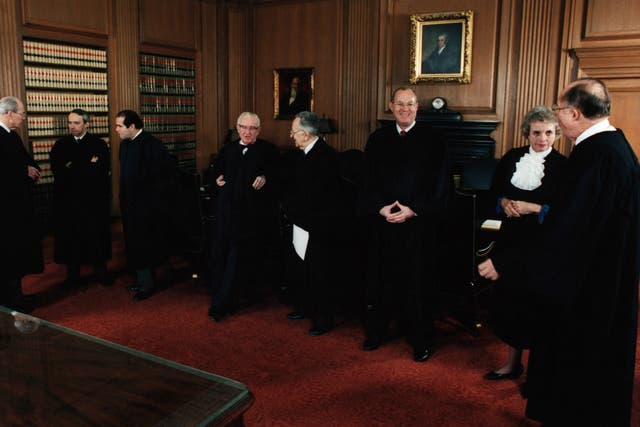

The U.S. Supreme Court's 1992 ruling in Planned Parenthood of Southeastern Pennsylvania v. Casey reaffirmed a woman's right to an abortion as granted in the 1973 Roe v. Wade case. However, the contentious 5-4 decision altered Roe and upheld a number of Pennsylvania abortion requirements cited in the case, while broadening the authority of states to regulate and restrict abortions. Casey was overturned in 2022, along with Roe v. Wade.
In the January 22, 1973, Roe v. Wade decision, the Supreme Court, in a 7-2 vote, ruled that abortion during the first trimester of pregnancy was a constitutional right protected by the 14th Amendment.
The ruling included a trimester framework in which it was left to a woman and her doctor to decide to have an abortion in the first trimester, a state could restrict, but not ban abortions in the second trimester and, in the third trimester, when a fetus is viable to survive outside of the womb, a state could ban abortion, except when necessary for a woman’s health or to save her life.
Following the ruling, a number of challenges to Roe and abortion rights restrictions ensued. In the 1976 Planned Parenthood v. Danforth case, the Supreme Court found parts of a Missouri abortion law unconstitutional, including required written consent from a woman’s husband. In 1980’s Harris v. McRae, the court held that, under Title XIX, states participating in Medicaid were not required to fund medically necessary abortions. In 1989, the court upheld restrictive abortion provisions in a Missouri law in Webster v. Reproductive Health Services.
Pennsylvania’s Abortion Control Act was amended in 1988 and 1989, adding five new provisions requiring informed consent, a 24-hour waiting period with information provided on alternatives to abortion, parental consent for minors in most cases, the notification of a woman’s husband that she planned to have an abortion and reporting to be completed by abortion providers.
Planned Parenthood of Southeastern Pennsylvania filed suit against the state of Pennsylvania, claiming the provisions were unconstitutional and in violation of the Roe v. Wade decision. The requirements were struck down by a federal district court, but all but the spousal notification provision were upheld by a U.S. court of appeals, which included the future Supreme Court Justice Samuel Alito.
With a more conservative-leaning court in place since the Roe verdict 19 years earlier, it came as a surprise to many when Roe’s constitutional right to an abortion was reaffirmed with a 5-4 vote on June 29, 1992.
The ruling cited “stare decisis,” or adhering to precedent, in upholding Roe. However, in a plurality decision, the court upheld all of the Pennsylvania abortion requirements, except for the provision that a woman’s husband must be notified of the procedure. It also changed the trimester framework set out in Roe, allowing states to regulate abortions before fetal viability as long as a “substantial obstacle” or “undue burden" is not added.
The majority decision was authored by Justices Sandra Day O’Connor, Anthony Kennedy and David Souter, who were joined by Justices Harry Blackmun and John Paul Stevens. Four justices, Chief Justice William Rehnquist, and Justices Byron White, Antonin Scalia and Clarence Thomas dissented. In a 7-2 vote, the four Pennsylvania restrictions were upheld, with Blackmun and Stevens dissenting.
While Casey reaffirmed a woman's right to an abortion, it also gave states more leeway in passing laws restricting abortion.
“The woman’s right to terminate her pregnancy before viability is the most central principle of Roe vs. Wade,” the majority authors wrote. “It is a rule of law and a component of liberty we cannot renounce.″
In 2022, the nation's highest court deliberated on Dobbs v. Jackson Women’s Health Organization, which regarded the constitutionality of a Mississippi law banning most abortions after 15 weeks of pregnancy. Lower courts had ruled the law was unconstitutional under Roe v. Wade, which guaranteed the right to an abortion before around 23 weeks—when a fetus is considered able to survive outside the womb.
In its decision, the Supreme Court ruled 6-3 in favor of Mississippi's law—overturning both Roe v. Wade and Planned Parenthood v. Casey.
“A History of Key Abortion Rulings of the U.S. Supreme Court,” January 16, 2013, Pew Research Center.
“High Court, 5-4, Affirms Right to Abortion But Allows Most of Pennsylvania's Limits,” by Linda Greenhouse, June 30, 1992, The New York Times.
“Roe and Casey: The two abortion precedents the Supreme Court may overturn,” by Joan Biskupic, December 1, 2021, CNN.
“How the Supreme Court went from cementing abortion rights in Roe v. Wade to drafting their demise,” by Kevin Breuninger, May 6 2022, CNBC.
“Roe established abortion rights. 20 years later, Casey paved the way for restrictions,” by Dipa Shivaram, May 6, 2022, NPR.
HISTORY.com works with a wide range of writers and editors to create accurate and informative content. All articles are regularly reviewed and updated by the HISTORY.com team. Articles with the “HISTORY.com Editors” byline have been written or edited by the HISTORY.com editors, including Amanda Onion, Missy Sullivan, Matt Mullen and Christian Zapata.